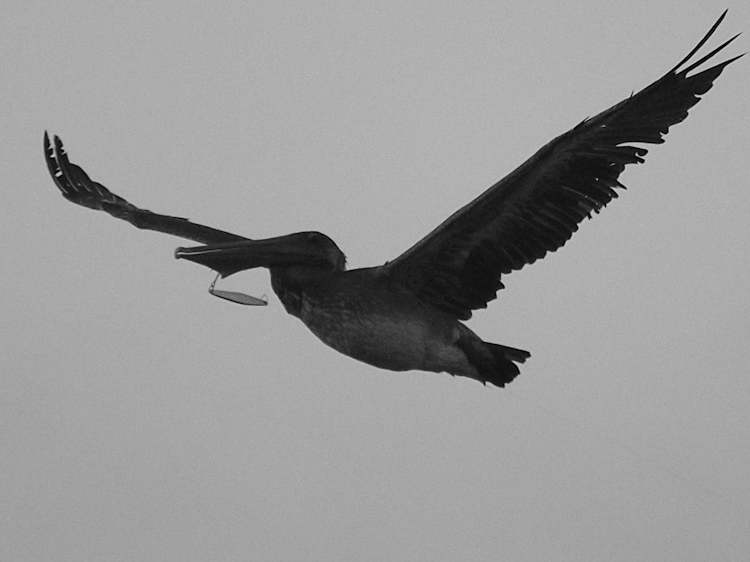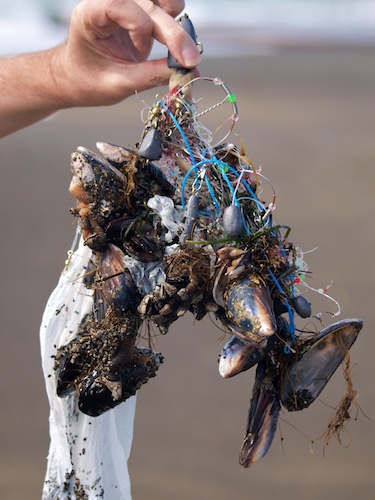Edited on 6/12/12 to add a few links and resources.
This was my last shot of the night. Under a California sky, I saw my favorite silhouettes on approach … those pterodactyl forms, Brown Pelicans, gliding past the fallen sun. Knowing I would get just the barest outline of a pelican, I raised my lens anyway, finding it impossible not to photograph these big birds I miss so much up here in the Northwest.
As I focused on the last pelican to fly overhead, I saw a large object dangling from its pouch. I feared it was precisely what this photograph shows it to be: a triple-hook fishing lure stuck in the pelican’s pouch, with a trailing line of monofilament visible in the bottom right corner of the image.

The pelican could fly well and high, and — short of an Ultralight aircraft on demand — there was no way reach the oceanic swells where he and his mates dissolved into the horizon. If the pelican gets too weak to fly, there is a chance for rescue … if he’s lucky enough to be found by the right people.
You’ve likely seen photos of Albatross carcasses, their bellies full of plastic trash. International Bird Rescue in California regularly takes in sea birds who’ve ingested fishing hooks, plastics, shotgun pellets and other human-contrived hazards that cause immense suffering and death for these animals. A lot of people encounter gulls or other birds with monofilament wrapped around their feet. Hugh and I often find and dispose of potential bird entanglements — like this mass of fishing hooks and filament we found on a Bay Area beach:
At an Emeryville fishing pier, I once found a series of hooks baited with large pieces of fish that concealed the hook. The hook tips were then stuck, deliberately and meticulously, into a wooden railing. To any passing gull or bird, they would have looked like a fast-food meal.
Even without aforethought and malice, marine debris is a significant hazard for sea birds — from commercial and recreational fishing gear, to the sea of wayward plastic we’ve come to know as the Great Pacific Garbage Patch (see video below). According to the California Coastal Commission, fishing monofilament can remain in the environment for 600 years. The Coastal Commission cites these additional figures:
“A recent study found an average of 334,271 pieces of plastic per square mile in the North Pacific Central Gyre, which serves as a natural eddy system to concentrate material.1 Results of more than 10 years of volunteer beach cleanup data indicate that 60 to 80 percent of beach debris comes from land-based sources. And debris in the marine environment means hazards for animals and humans. Plastic marine debris affects at least 267 species worldwide, including 86 percent of all sea turtle species, 44 percent of all sea bird species, and 43 percent of marine mammal species.”
The International Bird Rescue blog noted a study which showed that more than “30% of the animals harmed by fish hooks and entangled fishing line were Brown Pelicans” and that “pelican injuries caused by fishing gear were most common in the Monterey Bay region, where 59.6% of the pelicans rescued and admitted to a rehabilitation center were injured by fishing gear over the 6-yr period.” 1
States like Washington, where I currently live, are involved in derelict fishing gear removal projects, where the larger problems like derelict gill nets and crab pots are spotted, reported and removed from Puget Sound. These marine debris efforts are happening on national and international levels as well (see NOAA’s Marine Debris Program for more info). Many localities are also working to reduce monofilament (fishing line) waste by implementing disposal programs similar to this recycling and recovery program in Florida.
The California Coastal Commission has advice for properly stashing trash so that it doesn’t end up in the stomach of an Albatross … or in the pouch of a Brown Pelican. You can get more information at the CCC website, but some of the points are:
- Don’t dump plastics and trash overboard. It is illegal to discharge plastic anywhere in the ocean or in inland waterways.
- Bring it all back. Properly stash all containers and trash onboard to prevent it from being blown overboard.
- Take used monofilament fishing line back to recycling bins at your marina or tackle shop.
- Cigarette butts are the most common type of litter found washed up on beaches and are not biodegradable. Place extinguished cigarette butts in the trash.
==> Also … check out the 5Gyres website for information on reducing our personal plastic debris trail.
1) Journal of Wildlife Diseases, 45(2), 2009, pp. 355-362.


Ingrid,
I should be shocked by your image of the pelican with the fishing lure in its bill and the monofilament fishing line trailing behind the bird but I am not because I have seen scenes like this too many times to count. I’ve been able to get several birds that were hooked or entangled in fishing line to rescue groups but by the time the birds can no longer fly… it may be too late.
Mia, that does not surprise me in the least, that you’ve been hands on in several of those rescues. It consistently breaks my heart to see these things, no matter how often we all see them. And then, as you say, by the time they are grounded and can be captured, they are often emaciated or otherwise debilitated, making recovery much harder. I was doing rescue surveys during the Cosco Busan oil spill in SF, and the hardest thing was seeing a bird that was partially oiled but could still evade capture. You understand the inevitable in their situation — and there’s nothing you can do. The helplessness drives me mad at times.
This kind of thing is so very discouraging and all too common. Thanks for doing more than your share to help out these avian victims of our carelessness Ingrid.
ohhhhhhhh… this breaks my heart.
I’m now a subscriber to your journal.
Thanks so much for caring.
Deborah, thanks so much for stopping by. I’ve often said to my mate, Hugh, that taking up wildlife rehabilitation, one of the greatest things I ever did, also rendered me chronically sad. I mean that in the most existential way. I have great moments of joy, and yet they are punctuated by the awareness of this suffering. I realize that’s been the conundrum throughout time, for anyone who cared at all — finding a compassionate balance between attachment and detachment.
Thank you also for for viewing my journal as well, Ingrid.
The very next day after reading this post, while out on my hike in the Riverbed I picked up a very long and tangled strand of fishing filament. I stuck it in my pack and will use it to string some beads and feathers on… or something like that…
I love finding pretty feathers along the trails… sometimes I pick them up and put them in my “feather box”. Most are just common feathers, but I have some pretty unique ones as well. Such as Emu, and a beautiful, striped, Hawk feather.Yesterday I found a bright brown feather from a peacock wing. Very pretty.
I’m sure I recieved quite a few strange looks from others I passed with this long bright brown feather stuck in my hair
I have an addiction, I call it “Feather Love”.
Deborah, now that’s creative re-use! I love it. I’d love to know what you finally do with the filament. Feathers are so beautifully intricate. I have, quite a few times, been stumped by the coloration of a solitary feather. Often, I can guess by context/environment. But I don’t always know right off.
[…] post is (or will be) a rambling confluence of a few different stories. Back in June, I posted about a Brown Pelican I saw flying over Bolsa Chica at dusk. I photographed the bird in silhouette as it trailed a […]
louis vuitton アウトレット 店舗